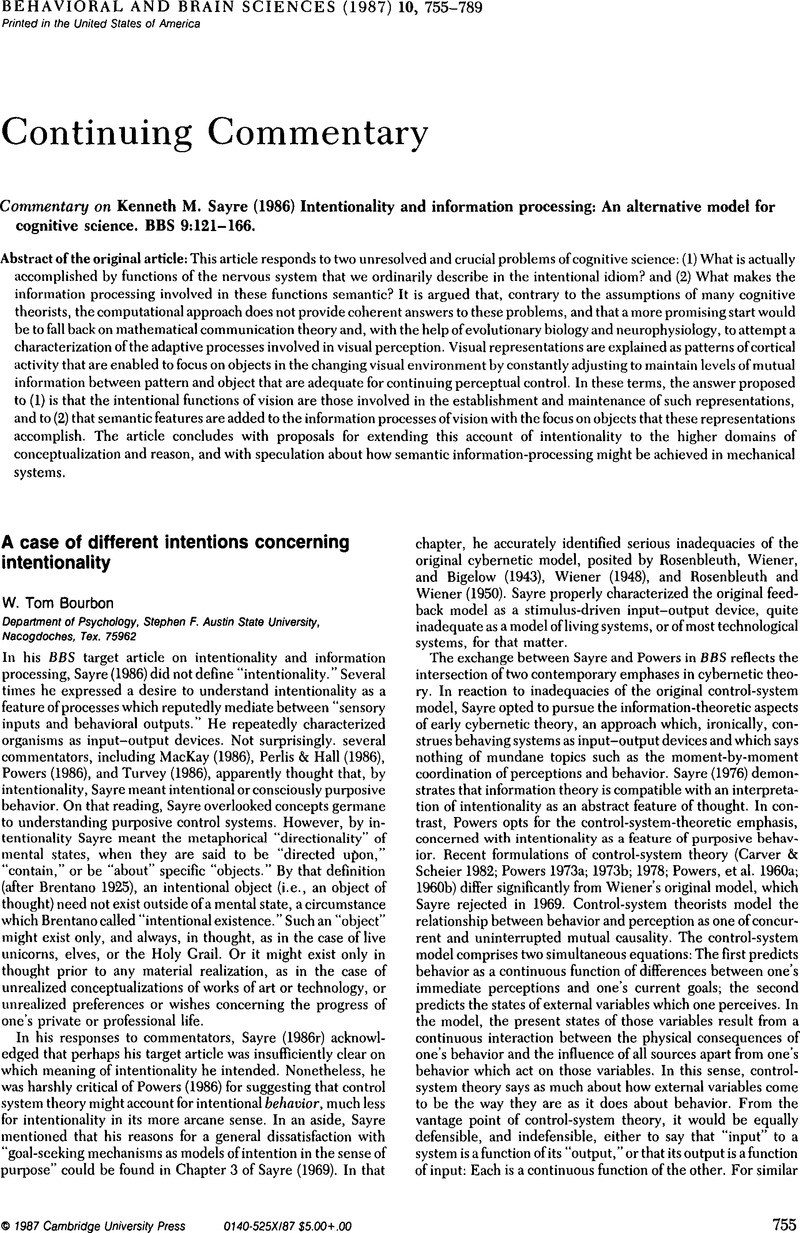No CrossRef data available.
Article contents
Information and the holism of intentional content
Published online by Cambridge University Press: 04 February 2010
Abstract
An abstract is not available for this content so a preview has been provided. Please use the Get access link above for information on how to access this content.

- Type
- Continuing Commentary
- Information
- Copyright
- Copyright © Cambridge University Press 1987
References
Brentano, F. (1925) The distinction between mental and physical phenomena. In: (1961) Realism and the background of phenomenology, ed. Chisholm, R. M.. Free Press. [WTB]Google Scholar
Brindley, G. S. & Lewin, W. S. (1968) The sensations produced by electrical stimulation of the visual cortex. Journal of Physiology 196:479–93. [RP]CrossRefGoogle ScholarPubMed
Brown, R., Earle, D. G, & Lea, S. E. C. (1986) Not an alternative model for intentionality in vision. Behavioral and Brain Sciences 9:138–39. [RVG, KP]CrossRefGoogle Scholar
Carver, C. S. & Scheier, M. F. (1982) Control theory: A useful conceptual framework for personality-social, clinical, and health psychology. Psychological Bulletin 92:111–35. [WTB]CrossRefGoogle ScholarPubMed
Churchland, P. M.(1986) Semantic content: In defense of a network approach. Behavioral and Brain Sciences 9:139–40. [RVG]CrossRefGoogle Scholar
Cummins, R.(1977) Programs in the explanation of behavior.Philosophy of Science 44:269–87. [CF]CrossRefGoogle Scholar
Cummins, R.(1983) The nature of psychological explanation. MIT Press/Bradford Books. [CF]Google Scholar
Dennett, D. C. (1971) Intentional systems. Journal of Philosophy 68:87–106. [RVG]CrossRefGoogle Scholar
Dretske, F. (1981) Knowledge and the flow of information. MIT Press/Bradford Books. [CF, KP]Google Scholar
Dubin, M., Stark, L. & Archer, S. (1986) A role for action-potential activity in the development of neuronal connections in the kitten retinogeniculate pathway. Journal of Neurosdence 6:1021–36. [CF]Google ScholarPubMed
Ellerman, D. P. (1986) Intentionality and information theory. Behavioral and Brian Sciences 9:143–44. [RVG]CrossRefGoogle Scholar
Gibson, J. J. (1979) The ecological approach to visual perception. Houghton–Mifflin. [CF]Google Scholar
Heil, J. (1986) Intentionally and the explanation of behavior. Behavioral and Brain Sciences 9:146–47. [RVG]CrossRefGoogle Scholar
Holmes, G. (1945) The organization of the visual cortex in man. Proceedings of the Royal Society (Biology) 132:348–61. [RP]Google Scholar
MacKay, D. M. (1986) Intrinsic versus contrived intentionality. Behavioral and Brain Sciences 9:149–50. [WTB, RVG]CrossRefGoogle Scholar
Marks, L. E. (1986) Cognitive science and the pragmatics of behavior. Behavioral and Brain Sciences 9:150. [RVG]CrossRefGoogle Scholar
Martin, C. B. & Pfeifer, K. (1986) Intentionality and the non-psychological. Philosophy and Phenomenological Research 46:531–54. [KP]CrossRefGoogle Scholar
Matthen, M. & Levy, E. (1984) Teleology, error, and the human immune system. Journal of Philosophy 81:351–72. [KP]CrossRefGoogle Scholar
Morphis, M. (1986) A total process approach to perception. Behavioral and Brain Sciences 9:150–51. [RVG, KP]CrossRefGoogle Scholar
Movshon, J. A. & van Sluyters, R.(1981) Visual neural development. Annual Review of Neuroscience 32:477–522. [CF]Google ScholarPubMed
Perlis, D. & Hall, R. (1986) Intentionality as internality. Behavioral and Brain Sciences 9:151–52. [WTB]CrossRefGoogle Scholar
Powers, W. T. (1973b) Feedback: Beyond behaviorism. Science 179:351–56. [WTB]CrossRefGoogle ScholarPubMed
Powers, W. T. (1978) Quantitative analysis of purposive systems. Psychological Review 85:417–35. [WTB]CrossRefGoogle Scholar
Powers, W. T. (1986) Intentionality: No mystery. Behavioral and Brain Sciences 9:152–53. [WTB, KMS]CrossRefGoogle Scholar
Powers, W. T., Clark, R. K. & McFarland, R. L. (1960a) A general feedback theory of behavior. I. Perceptual and Motor Skills Monograph 11(1, Serial No. 7). [WTB]Google Scholar
Powers, W. T., Clark, R. K. & McFarland, R. L.(1960b) A general feedback theory of behavior. II. Perceptual and Motor Skills Monograph 11(3, Serial No. 7). [WTB]Google Scholar
Rosenbleuth, A. & Wiener, N. (1950) Purposeful and non-purposeful behavior. Philosophy of Science 17:318–26. [WTB]CrossRefGoogle Scholar
Rosenbleuth, A., Wiener, N. & Bigelow, J. (1943) Behavior, purpose and teleology. Philosophy of Science 10:18–24. [WTB]CrossRefGoogle Scholar
Sayre, K. M. (1969) Consciousness: A philosophic study of minds and machines. Random House. [WTB, KMS]Google Scholar
Sayre, K. M. (1976) Cybernetics and the philosophy of mind. Routledge and Kegan Paul. [WTB, KMS]Google Scholar
Sayre, K. M. (1986) Intentionality and information processing: An alternative model for cognitive science. Behavioral and Brain Sciences 9:121–65.CrossRefGoogle Scholar
Sayre, K. M. (1986r) Intentionality and communication theory. Behavioral and Brain Sciences 9:155–63. [WTB, RVG, KMS]CrossRefGoogle Scholar
Sayre, K. M. (1987) Cognitive science and the problem of semantics content. Synthese 70:247–69. [KMS]CrossRefGoogle Scholar
searle, J. R. (1980) Minds, brains, and programs. Behavioral and Brain Sciences 3:417–57. [CF, RP]CrossRefGoogle Scholar
Shannon, C. E. & Weaver, W. (1949) The mathematical theory of communication. University of Illinois Press. [KP]Google Scholar
Stampe, D. (1977) Toward a causal theory of linguistic representation. Midwest Studies in Philosophy 2:42–63. [CF]CrossRefGoogle Scholar
Smith, B.(1982) Semantic attribution and the formality constraint. Xerox (Palo Alto Research Center) preprint. [CF]Google Scholar
Turvey, M. T. (1986) Intentionality: A problem of multiple reference frames, specificational information, and extraordinary boundary conditions on natural law. Behavioral and Brain Sciences 9:153–55. [WTB, CF]CrossRefGoogle Scholar
Wiener, N. (1948) Cybernetics: Control and communication in the animal and the machine. MIT Press. [WTB]Google Scholar


